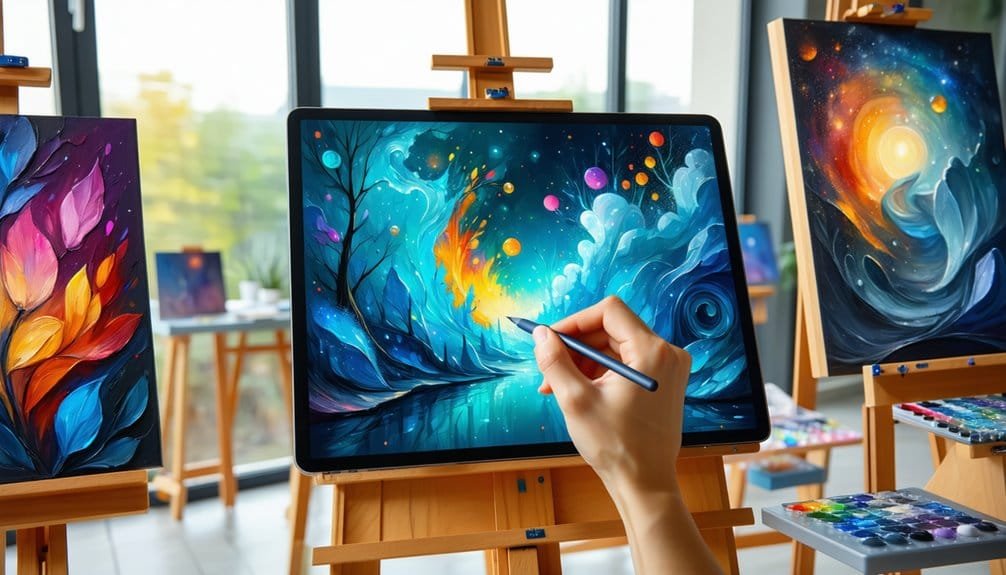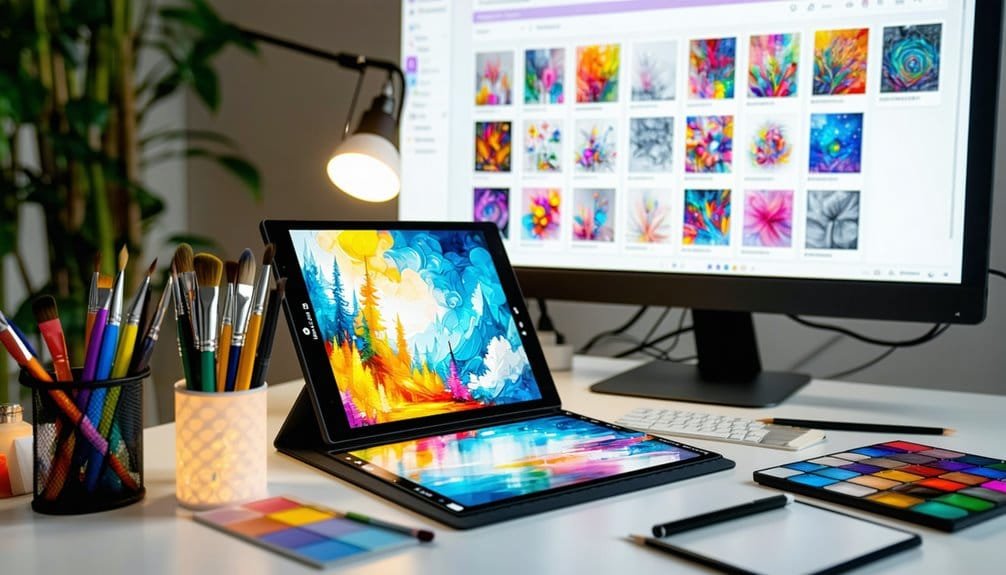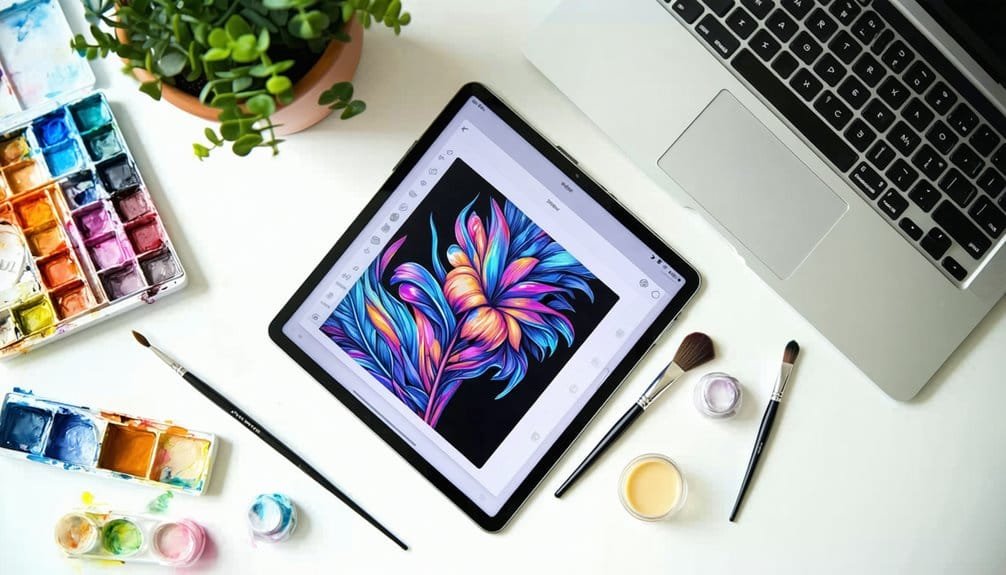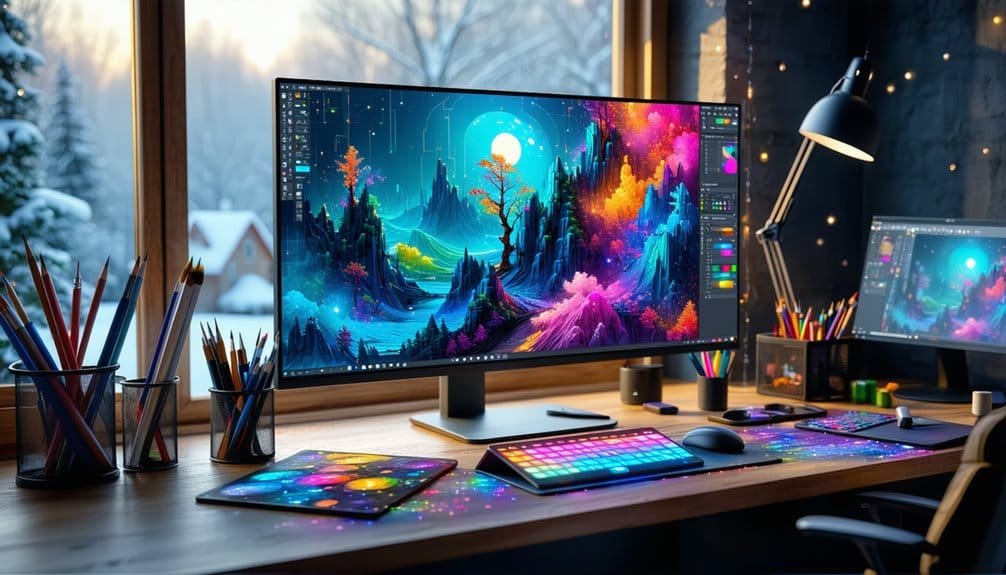To craft your first NFT digital art masterpiece, start by understanding that NFTs are unique digital assets that represent ownership and authenticity, secured by blockchain technology. Use software like Adobe Photoshop or Procreate to create engaging art, considering popular styles and techniques. Once your artwork is ready, choose a reputable marketplace such as OpenSea or Rarible to mint and sell your NFT, being mindful of transaction fees. Promote your creation through social media and community engagement strategies to attract buyers. This process involves both creativity and strategy, leading to potential success in the dynamic NFT market. More insights await as you explore further.
Table of Contents
Brief Overview
- Research trending art styles and concepts to inspire your unique digital artwork for NFT creation.
- Utilize software like Adobe Photoshop or AI tools to enhance creativity and design quality in your digital art.
- Ensure your digital art meets marketplace requirements regarding file formats and size before uploading.
- Select a reputable NFT marketplace, like OpenSea or Rarible, for minting and listing your artwork securely.
- Promote your NFT through social media, engaging with communities to attract potential buyers and increase visibility.
Summary of Create NFT Digital Art Masterpiece
| Aspect | Details | Tips & Considerations |
|---|---|---|
| Understanding NFTs | NFTs are unique digital assets secured by blockchain, representing ownership and authenticity. | Emphasize digital scarcity and ensure blockchain transparency to build trust and credibility in the market. |
| NFTs enable creative monetization, allowing artists to sell directly to collectors while retaining intellectual property rights. | Stay aware of market fluctuations and associated risks to maximize profitability. | |
| Selecting a Marketplace | Choose marketplaces like OpenSea or Rarible for diverse audiences or curated platforms like SuperRare for exclusive, high-quality listings. | Understand platform fees, transaction fees, and approval processes to select the best fit for your art. |
| Niche platforms like NBA Top Shot cater to specific themes, offering focused audiences but limiting scope. | Evaluate marketplace features, security, and community strength before committing. | |
| Transaction Fees | Ethereum gas fees can be high, while alternatives like Solana or Tezos offer minimal costs. | Use gasless minting options or explore platforms with lower fees to optimize costs. |
| Creating Digital Artwork | Use tools like Photoshop, Procreate, or Blender for creating and enhancing digital art. | Experiment with trending art styles and incorporate unique features to make your artwork stand out. |
| Explore AI tools like Midjourney or NFT Art Generator for creating generative art. | Leverage templates or augmented reality tools to add interactive elements to your work. | |
| Preparing Artwork | Ensure your art meets marketplace requirements regarding file formats (PNG, JPEG, GIF, MP4) and size. | Research the platform’s audience to tailor your style and format preferences. |
| Minting Your NFT | Mint your NFT on a blockchain like Ethereum or Solana through a marketplace interface. | Be mindful of gas fees during the minting process and consider timing for lower transaction costs. |
| Include metadata with details like creation date, ownership history, and royalties. | Metadata enhances authenticity and resale value, providing additional appeal to collectors. | |
| Setting Unique Properties | Utilize unique identifiers, indivisibility, and blockchain storage for proof of authenticity and ownership. | Incorporate smart contracts for automated royalties and secure transactions. |
| Listing Your NFT for Sale | Choose between fixed price or auction models and optimize titles, descriptions, and tags for discoverability. | Double-check listing details to avoid errors and select a platform with strong buyer activity for higher visibility. |
| Promoting Your NFT | Use social media platforms like Twitter, Instagram, and TikTok for high-quality content sharing. | Engage directly with audiences through behind-the-scenes posts, artist stories, and previews to build interest. |
| Collaborate with influencers or brands to expand your reach. | Leverage email campaigns and community engagement on Discord or Telegram to maintain long-term relationships with collectors. | |
| Engaging with the Community | Host virtual meetups, contests, and giveaways to foster community participation and loyalty. | Actively listen to community feedback to improve offerings and enhance engagement. |
| Collaborate with other NFT creators or projects for cross-promotion opportunities. | Clear communication and transparency help build trust and maintain collector interest. |
Understanding NFTs and Their Importance

In recent years, NFTs have emerged as a revolutionary force in the digital landscape, transforming how we think about ownership and value. Understanding their significance is essential, especially as you investigate the world of digital art. At their core, NFTs are unique digital assets that represent ownership rights to virtual items like art, music, and videos. Unlike cryptocurrencies, NFTs are non-fungible, meaning each one is distinct and cannot be replaced.
The concept of digital scarcity is central to NFTs. Thanks to blockchain technology, each NFT’s ownership and provenance are recorded transparently, ensuring authenticity and preventing counterfeiting. This transparency is fundamental for building trust in a market that can experience fluctuations. Additionally, NFTs enable creative monetization for artists, allowing them to sell their work directly to collectors. Intellectual property rights for NFTs typically remain with the original creator, ensuring they retain control over their work. Moreover, the unique identification code ensures the originality of NFTs, which further solidifies their value in the digital marketplace.
As you explore deeper into collectible trends, you’ll notice the growing interest in NFTs as investment opportunities. While some NFTs have sold for impressive amounts, it’s important to stay aware of market fluctuations and the associated risks. Furthermore, environmental concerns regarding the energy consumption of blockchain technology have sparked discussions about sustainability in the NFT space.
Selecting the Right Marketplace
When selecting the right NFT marketplace, you’ll want to contemplate the type of platform that aligns with your goals and the transaction fees involved. For instance, platforms like Foundation and SuperRare cater to high-end, curated art, while OpenSea offers a more diverse range but comes with higher gas fees. Additionally, platforms like Rarible provide community ownership incentives through the use of their ERC-20 RARI token, rewarding active users and promoting engagement. By understanding these key characteristics, you can make an informed choice that maximizes your art’s potential. The art NFT market size grew to $41 billion in a year, highlighting the increasing opportunities for artists in this space.
Marketplace Types Overview
Choosing the right marketplace for your NFT digital art is essential for maximizing visibility and sales. You can choose from various marketplace types, each with its own advantages and challenges. Open marketplaces, like OpenSea and Rarible, allow you to list any type of NFT easily. Their broad user base offers excellent exposure, but the sheer volume of listings can make it hard to stand out.
Curated marketplaces, such as SuperRare and Nifty Gateway, focus on high-quality, selected NFTs. While this provides a certain level of prestige and attracts collectors looking for unique art, the approval process can be a barrier for new artists. Additionally, many platforms charge platform fees that can impact your overall earnings on sales. It’s important to note that verification processes vary across platforms, influencing your choice based on security needs.
Niche marketplaces, like Axie Infinity and NBA Top Shot, cater to specific interests, making them appealing if your art aligns with those themes. They often create a focused environment but might limit your audience.
Hybrid marketplaces blend features from both open and curated options, offering flexibility. However, maneuvering through these platforms may present a learning curve. By understanding these marketplace types, you can select the one that aligns with your goals while considering the safety and security of your transactions.
Transaction Fees Considerations
Maneuvering transaction fees is vital for artists diving into the NFT space, as these costs can considerably impact your profits. When selecting a marketplace, it’s important to weigh gas fee strategies alongside platform fee comparisons. For instance, Ethereum’s gas fees can soar up to $150, making it an expensive choice for minting. In contrast, platforms like Solana and Tezos offer minimal fees, often less than a cent, allowing you to experiment without financial strain. This is especially advantageous as high costs present barriers for artists and creators entering the NFT space. Additionally, understanding minting fee structures is crucial to avoid unexpected expenses while creating an nft.
While OpenSea charges a 2.5% transaction fee, X2Y2 provides a more appealing 0.5% fee, attracting cost-conscious creators. You might find LooksRare and Magic Eden’s 2% fees appealing too. Remember that some platforms, such as Mintable, even offer gasless minting options, reducing upfront costs.
It’s important to take into account secondary sales fees as they can affect your long-term earnings. Choosing a marketplace with a strong community can also enhance your experience, providing support and collaboration opportunities. Ultimately, balancing these fees with the potential reach and engagement of the platform will help guarantee your NFT journey is both profitable and enjoyable.
Creating Your Digital Artwork

When you’re ready to create nft art, selecting the right tools is essential. Popular software like Photoshop, Procreate, and Adobe Illustrator can help you bring your ideas to life, whether you’re making a digital painting or experimenting with AI art generation. Understanding the capabilities of these tools will enable you to craft unique pieces that stand out in the NFT space. Additionally, using NFTs for unique individuality can further enhance the appeal of your artwork in the competitive market. Remember, the ownership of NFTs is recorded on blockchain technology, ensuring each piece has a verifiable and distinct identity. Consider exploring how NFTs challenge traditional ownership to gain insights into their transformative potential in the art world.
Tools for Digital Creation
Creativity thrives when you have the right tools at your disposal for crafting digital artwork. Whether you’re into digital painting or vector design, software like Adobe Photoshop and Illustrator can elevate your NFT creations. For those who prefer a more expressive touch, Procreate is an excellent choice for detailed digital paintings that capture emotion. If 3D modeling intrigues you, Blender offers extensive capabilities to produce immersive NFTs. Additionally, many of these tools come with intuitive interfaces that enhance creative focus and simplify the creative process for beginners. Moreover, leveraging NFTs as unique digital assets can add significant value to your creations.
For innovative approaches, consider augmented reality tools like SketchAR, which merge art with interactive technology. If you’re looking to create NFT variations efficiently, platforms like NFT Art Generator simplify this process, allowing you to produce large collections with ease.
Generative art enthusiasts will appreciate no-code tools like Bueno and NFTify, which help you launch unique NFT marketplaces without technical skills. Batch minting features available on Cargo allow for the efficient creation of multiple NFTs, while voxel creation tools like VoxEdit cater to specific styles for platforms like The Sandbox. Finally, template design tools from Fotor NFT Creator streamline your workflow, ensuring safety and accessibility in your artistic journey.
AI Art Generation
With the right tools in place, you can explore the exciting world of AI art generation to create unique digital artwork. AI art combines deep learning algorithms and neural networks to transform text prompts into stunning visuals. By understanding prompt engineering, you can provide detailed descriptions that guide the AI, ensuring it produces the artwork you envision.
Using generative techniques like diffusion models, platforms such as Midjourney gradually refine images until they match your specifications. This process allows for significant art customization, enabling you to experiment with style variation and combine different artistic influences. Moreover, the popularity of AI art stems from its accessibility for untrained creators, enabling a diverse range of individuals to engage in art-making. Additionally, AI art creation is made possible through various platforms like Jasper and Leonardo AI, which offer user-friendly interfaces for generating art.
To enhance your creations, consider image refinement through software that adjusts lighting, colors, and composition. You can also collaborate with AI by combining outputs from multiple generators, leading to more nuanced pieces.
Preparing Your Artwork for NFTs
Preparing your artwork for NFTs involves several key steps that can greatly enhance its appeal and marketability. Start with concept development; understanding what you want to create is essential. Research trending art styles, such as pixel art, cartoons, or 3D characters, to stimulate your creative exploration. Digital sketching allows you to iterate quickly, making modifications as needed.
To guarantee your artwork stands out, focus on texture utilization and color strategies. These elements can add depth and vibrancy to your piece. Utilize tools like Photoshop or Illustrator for crafting your digital masterpiece. You also have animation options, such as GIFs or MP4s, to bring your artwork to life. Technological advancements enable anyone to create art using AI tools, expanding the possibilities for your NFT creations. Additionally, understanding NFT marketplaces will help you tailor your artwork to meet the preferences of potential buyers.
When preparing your artwork, keep in mind the file formats and size limitations of the NFT marketplaces. Below is a helpful guide to common formats and their applications:
| File Format | Best Use |
|---|---|
| PNG | High-quality images |
| JPEG | Complex, detailed works |
| GIF | Simple animations |
| MP4 | Rich animations |
| TIFF | High-quality, large-scale works
Uploading and Minting Your NFT

Uploading and minting your NFT is a straightforward process that opens the door to sharing your digital art with a global audience. By following a few essential steps, you can safely navigate the uploading process and mint your unique digital asset. Here’s a quick guide to get you started:
- Choose a Reputable Marketplace: Select an NFT marketplace like OpenSea or Rarible to guarantee a secure environment for your art.
- Create an Account: Follow the marketplace’s instructions to set up your account.
- Connect Your Crypto Wallet: Link your wallet to the marketplace for smooth transactions and minting steps.
- Understand File Requirements: Be aware of file formats (PNG, JPEG, GIF, MP4) and size restrictions (often up to 100 MB).
Once you’ve uploaded your artwork, you’ll move on to the minting steps. Selecting a popular blockchain, such as Ethereum, is vital, as it supports NFT creation. Remember, minting will incur a gas fee, which compensates the miners for processing your transaction. After minting, you can list your NFT for sale by either setting a fixed price or opting for an auction.
Always keep safety in mind throughout this process. Regularly check your listings for offers and engage with the NFT community for increased visibility. By following these structured steps, you’ll be well on your way to successfully uploading and minting your NFT, making your digital art accessible to a broader audience.
Setting Unique NFT Properties
When crafting your NFT, setting unique properties is fundamental to defining its value and appeal. Each NFT features unique identifiers, ensuring that no two pieces are alike. This individuality not only distinguishes your artwork but also establishes its authenticity. By leveraging these unique identifiers, you can provide collectors with proof of scarcity, an essential factor in the art market.
NFTs are indivisible, meaning they can’t be broken down into smaller parts. This quality maintains the integrity of your digital art and reinforces its worth. Additionally, NFTs are transferable on the blockchain, allowing seamless ownership transfers while ensuring security and transparency.
Incorporating metadata into your NFT is also significant. This data contains detailed information about your artwork, including its creation date, ownership history, and any royalties associated with future sales. Smart contracts automate these transactions, providing peace of mind that ownership will be securely transferred.
The blockchain serves as a reliable storage solution, bolstering the proof of scarcity and ownership. As a creator, you can directly engage with collectors, bypassing intermediaries and enhancing your control over the sales process. This direct connection not only fosters trust but also opens new market opportunities.
Listing Your NFT for Sale

Typically, listing your NFT for sale involves several key steps that guarantee its visibility and appeal to potential buyers. By carefully considering your listing strategies and price settings, you can enhance your chances of a successful sale. Here are four essential steps to follow:
- Choose the Right Platform: Select a marketplace like OpenSea, Rarible, or Mintable. Each platform has different fee structures and features, so weigh your options carefully.
- Mint Your NFT: Before listing, verify your NFT is minted on a blockchain like Ethereum or Solana. This step creates a unique token for your digital asset.
- Prepare Your Listing: When creating your listing, include essential details such as price, quantity, and whether it’s for a fixed price or auction. Use descriptive titles and tags to increase discoverability.
- Review and Confirm: Once you’ve filled in the necessary information, double-check your listing for accuracy. Verify you understand any associated fees and confirm the sale details.
Keep in mind that you cannot list the same NFT on multiple platforms simultaneously, so choose wisely. After listing, you can manage your sale by reviewing offers and tracking your NFT’s performance. Stay vigilant against potential scams or malicious bids, and always prioritize secure transactions. By following these steps, you’ll create a compelling listing that attracts potential buyers while providing a safe selling experience.
Promoting Your NFT Effectively
Promoting your NFT effectively is essential for gaining visibility in a crowded marketplace. To start, leverage social media platforms like Twitter, Instagram, and TikTok. These channels allow you to showcase your artwork and engage directly with potential buyers. High-quality content creation is vital; share behind-the-scenes insights, artist stories, and exclusive previews to capture interest.
Consider influencer partnerships and brand collaborations to expand your reach. Collaborating with established influencers or brands not only boosts your credibility but also introduces your NFT to new, engaged audiences. You can create unique, co-branded NFTs that align with their followers, enhancing visibility while providing added value.
Utilize cross promotion strategies by connecting with other NFT collections. This approach can help you tap into their community, fostering goodwill and shared interest. Community engagement is key; actively participate in conversations on platforms like Discord and Telegram to build relationships and trust with NFT enthusiasts.
Email campaigns are another effective tool. Use analytics tools to track the success of your campaigns, refining your strategies based on data insights. Regular newsletters can keep your audience informed about new drops, events, or special promotions.
Engaging With the NFT Community

Engaging with the NFT community is essential for building lasting relationships and fostering loyalty among collectors. A strong community not only enhances your project’s visibility but also enriches the experiences of its members. Here are four strategies you can implement for effective community engagement:
- Identify Your Target Audience: Understand who your potential collectors are and what interests them. This will help tailor your content and initiatives.
- Host Virtual Meetups: Organize online gatherings where NFT holders can connect, share experiences, and discuss your art. This fosters a sense of belonging.
- Implement Feedback Gathering: Use surveys and suggestion boxes to gather feedback. This shows you value your community’s opinions and helps in making informed decisions.
- Create Interactive Initiatives: Engage your audience through contests, giveaways, and gamified elements like polls and quizzes. These strategies not only increase participation but also enhance the community experience.
Fostering diversity inclusion is critical in creating an environment where all members feel valued. As you build collaborative partnerships with artists and influencers, you’ll expand your reach and credibility. Regular updates and clear communication through social media or newsletters keep your community informed and engaged.
Frequently Asked Questions
What Are the Environmental Impacts of Creating NFTS?
Creating NFTs has considerable environmental impacts, primarily linked to energy consumption and carbon footprint. Each NFT creation emits about 83kg of CO2, equivalent to the absorption of 1.38 trees over their lifespan. Additionally, transactions like bidding and selling contribute further emissions, with bidding alone generating around 23kg of CO2. However, advancements like the Ethereum Merge have greatly reduced energy use, making newer NFTs more sustainable on proof-of-stake networks.
How Do I Price My NFT Artwork Effectively?
To price your NFT artwork effectively, consider various pricing strategies that reflect market trends. Start by evaluating your reputation as an artist, as it can greatly influence value. Examine the rarity of your piece; the fewer copies you offer, the higher the price can be. Monitor market conditions, as they fluctuate between bullish and bearish phases. Engaging with your audience on social media can also help gauge interest, informing your pricing decisions.
Can I Create NFTS Using Traditional Art?
Yes, you can create NFTs using traditional art. This digital transformation allows you to merge traditional techniques with modern technology. Start by digitizing your artwork, ensuring high resolution for clarity. Then, select an NFT marketplace to mint your creation. It’s essential to understand that each NFT must be unique and registered on the blockchain for authenticity. This method not only preserves your art but also opens new avenues for monetization and global exposure.
What Happens if My NFT Doesn’t Sell?
If your NFT doesn’t sell, it’s essential to reassess your marketing strategies and boost audience engagement. Explore different platforms to showcase your work and connect with potential buyers. Use social media to share your creative process, which can foster interest. Additionally, consider collaborating with other artists or participating in online communities. These actions can enhance visibility and increase the likelihood of attracting buyers, ultimately improving your chances of a successful sale.
Are There Legal Issues Related to NFT Ownership?
Yes, there are legal issues related to NFT ownership, particularly concerning copyright concerns and ownership rights. When you purchase an NFT, you don’t automatically acquire the rights to the underlying content. Ownership rights must be explicitly defined and transferred through contracts. Additionally, you need to take into account compliance with regulations, as NFTs may fall under securities laws depending on how they’re marketed. Understanding these aspects is essential to navigate the NFT landscape safely.
Summarizing
To sum up, creating your first NFT digital art masterpiece involves several critical steps, from understanding NFTs to engaging with the community. By selecting the right marketplace, preparing your artwork, and promoting your NFT effectively, you position yourself for success in this evolving digital landscape. Remember, the NFT space thrives on innovation and community support, so stay informed and connected. With dedication and creativity, you can make a meaningful impact in the world of digital art.



